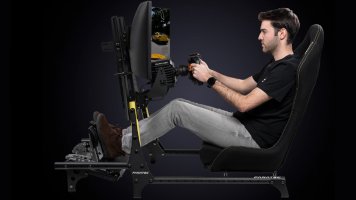That's up to debate and I don't think there's a real right or wrong. A heavy mouse will basically reduce your "hand jitter" by smoothing it out with inertia.
But I'd say a light mouse with a mouse pad that has a bit higher resistance, but no extra initial resistance, will work better since you just get more friction, without adding inertia to the movement.
I have very calm hands and I love that I'm able to move the mouse around with my finger tips. I'm using a mix of palm grip and fingertip grip: Wrist on the mouse pad, hand relaxed onto the mouse. Rear end of it is slightly, but not really touching my palm.
But I can lay my whole palm on the mouse to relax too, it's quite big.
On the Desktop, I can move the cursor from left edge to right edge of my 3440x1440 monitor without lifting my wrist. I guess 32:9 would be the limit with this sensitivity.
Pixel-accurate movements are done by letting my thumb and little finger touching the mouse pad and moving the mouse with just my fingertips.
Most movements aren't via the wrist and more just by moving my fingers.
Got a low to semi friction, cloth pad:
Razer Pro Glide - 36x27.5 cm
When carefully touching the mouse with a fingertip, there's no initial resistance to overcome, just a tiny bit of friction.
I can recommend, when in need for a new mouse or unhappy with the current one, to try this experience. For my friend, who has pretty bad hand jitter, it's awful. But he doesn't play any fast paced games at all. For another friend who mostly plays Apex Legends, it was a game changer. I gave him my Superlight for a week and after a few days he said he could never go back to a heavier mouse.
A third mate was like "You guys have problems... I just play and save money with my corded Razer Deathadder for sub 30€"

But anyway, to "troll" a bit

:
They key to success in any FPS is perfect mouse aim, and with our list of ten tips you'll be sure to never miss your target!

www.overclockers.co.uk
While there’s no easy or short solution, there are plenty of things you can be doing to improve your aim. In fact, we’ve got ten useful tips to help you achieve perfect mouse aim.
Get a Lightweight Mouse
First things first, let’s take a look at the tools you’re working with. Since you will be using your gaming mouse to aim you want to choose yours carefully. As well as ensuring the shape is comfortable, a lighter weight can be a key difference maker. A lightweight mouse is easier to accelerate and stop, giving you finer control if you adjust your sensitivity accordingly. It’s also less strenuous if you find yourself moving your gaming mouse frequently and extensively.













